【外研版】高中英语必修四:Module4Greatscientists语法学案含答案
- 格式:doc
- 大小:120.50 KB
- 文档页数:7
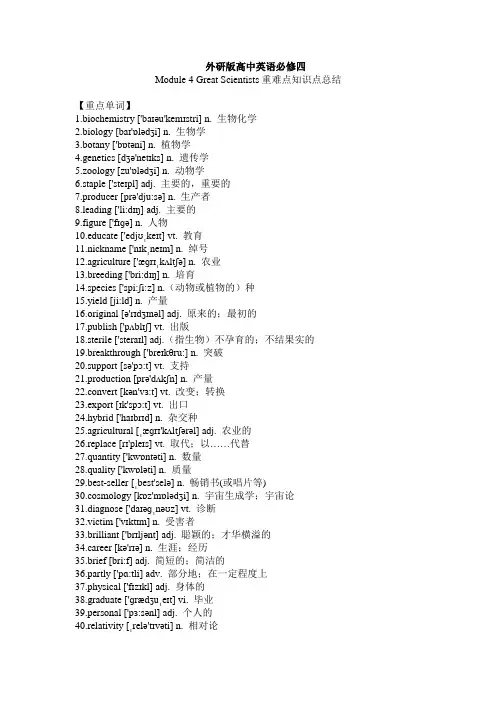
外研版高中英语必修四Module 4 Great Scientists 重难点知识点总结【重点单词】1.biochemistry ['baɪəu'kemɪstri] n. 生物化学2.biology [baɪ'ɒlədʒi] n. 生物学3.botany ['bɒtəni] n. 植物学4.genetics [dʒə'netɪks] n. 遗传学5.zoology [zu'ɒlədʒi] n. 动物学6.staple ['steɪpl] adj. 主要的,重要的7.producer [prə'dju:sə] n. 生产者8.leading ['li:dɪŋ] adj. 主要的9.figure ['fɪɡə] n. 人物cate ['edjʊˌkeɪt] vt. 教育11.nickname ['nɪkˌneɪm] n. 绰号12.agriculture ['æɡrɪˌkʌltʃə] n. 农业13.breeding ['bri:dɪŋ] n. 培育14.species ['spi:ʃi:z] n.(动物或植物的)种15.yield [ji:ld] n. 产量16.original [ə'rɪdʒɪnəl] adj. 原来的;最初的17.publish ['pʌblɪʃ] vt. 出版18.sterile ['steraɪl] adj.(指生物)不孕育的;不结果实的19.breakthrough ['breɪkθru:] n. 突破20.support [sə'pɔ:t] vt. 支持21.production [prə'dʌkʃn] n. 产量22.convert [kən'vɜ:t] vt. 改变;转换23.export [ɪk'spɔ:t] vt. 出口24.hybrid ['haɪbrɪd] n. 杂交种25.agricultural [ˌæɡrɪ'kʌltʃərəl] adj. 农业的26.replace [rɪ'pleɪs] vt. 取代;以……代替27.quantity ['kwɒntəti] n. 数量28.quality ['kwɒləti] n. 质量29.best-seller [ˌbest'selə] n. 畅销书(或唱片等)30.cosmology [kɒz'mɒlədʒi] n. 宇宙生成学;宇宙论31.diagnose ['daɪəɡˌnəʊz] vt. 诊断32.victim ['vɪktɪm] n. 受害者33.brilliant ['brɪljənt] adj. 聪颖的;才华横溢的34.career [kə'rɪə] n. 生涯;经历35.brief [bri:f] adj. 简短的;简洁的36.partly ['pɑ:tli] adv. 部分地;在一定程度上37.physical ['fɪzɪkl] adj. 身体的38.graduate ['ɡrædʒuˌeɪt] vi. 毕业39.personal ['pɜ:sənl] adj. 个人的40.relativity [ˌrelə'tɪvəti] n. 相对论41.rocket ['rɒkɪt] n. 火箭lennium [mɪ'leniəm] n. 千年43.gunpowder [ɡʌnˌpaʊdə] n. 火药44.explosion [ɪk'spləʊʒn] n. 爆炸;爆炸声45.explode [ɪk'spləʊd] vi. 爆炸46.escape [ɪ'skeɪp] vi. 逃跑;逃避47.arrow ['ærəʊ] n.(弓)箭48.straight [streɪt] adj. 直的49.clear [klɪə] vi.(烟雾)消散【重点短语】1.experiment with sth. 用某物实验2.experiment on sth. 对某物进行实验3.carry out/perform/conduct an experiment 做实验4.make a breakthrough 取得重大突破(进展)5.convert A into/to B 把A转换成B6.take the place of 取代,代替7.instead of 代替,而不是8.bring up 抚育;教养;呕吐;提出(话题等)9.bring down 降低10.bring about 导致,引起11.bring back 归还;恢复;回想12.bring in 赚(钱);带进;传入13.search for 寻找14.search sb./someplace 搜查某人或某地15.in search of 寻求/寻找……16.as a result of 由于……的结果17.as a result 因此,结果18.owing to/thanks to 由于19.the key to… ……的关键20.export sth. to 出口某物到……21.the second most important 第二重要的22.be interested in… 对……感兴趣23.graduate from… 从……(地方)毕业24.escape from /out of someplace 从某地逃脱/逃走25.escape from reality 逃避现实26.have a narrow escape 九死一生27.a fire escape 紧急出口;安全门28.clear up (天气)放晴;整理;收拾29.be known for 因……而出名/闻名30.earn one’s living 谋生e to power 掌权;执政32.take power 取得政权33.It is possible that…. 可能……34.It’s certain that... 肯定……35.It’s likely that… 可能……36.It seems that... 好像……37.at war 在交战中38.be diagnosed with 被诊断出;患有39.become the voice of... 成为……的代言人40.partly because of 部分原因是【重点句型】1.She needs a high income to support such a large family.她需要一份高收入来养活这么一大家子。
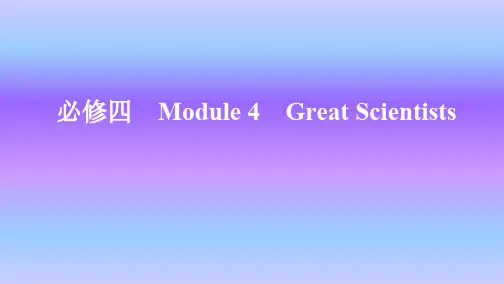
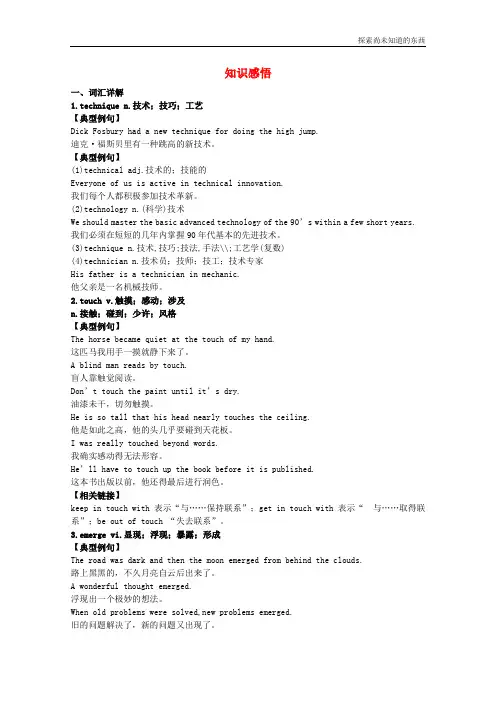
知识感悟一、词汇详解1.technique n.技术;技巧;工艺【典型例句】Dick Fosbury had a new technique for doing the high jump.迪克·福斯贝里有一种跳高的新技术。
【典型例句】(1)technical adj.技术的;技能的Everyone of us is active in technical innovation.我们每个人都积极参加技术革新。
(2)technology n.(科学)技术We shoul d master the basic advanced technology of the 90’s within a few short years.我们必须在短短的几年内掌握90年代基本的先进技术。
(3)technique n.技术,技巧;技法,手法\\;工艺学(复数)(4)technician n.技术员;技师;技工;技术专家His father is a technician in mechanic.他父亲是一名机械技师。
2.touch v.触摸;感动;涉及n.接触;碰到;少许;风格【典型例句】The horse became quiet at the touch of my hand.这匹马我用手一摸就静下来了。
A blind man reads by touch.盲人靠触觉阅读。
Don’t touch the paint until it’s dry.油漆未干,切勿触摸。
He is so tall that his head nearly touches the ceiling.他是如此之高,他的头几乎要碰到天花板。
I was really touched beyond words.我确实感动得无法形容。
He’ll have to touch up the book before it is published.这本书出版以前,他还得最后进行润色。
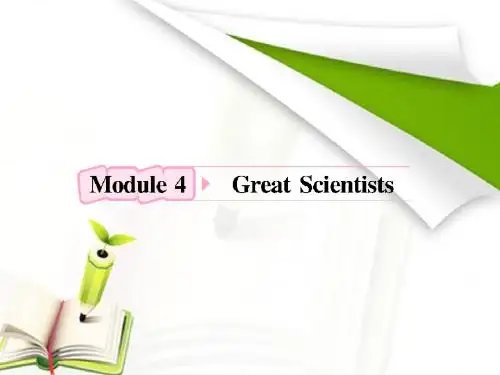
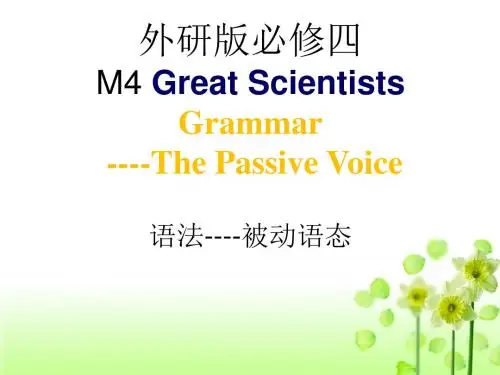
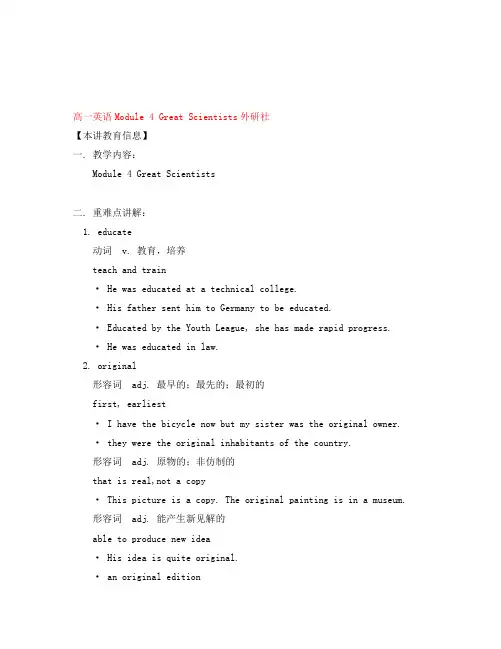
高一英语Module 4 Great Scientists外研社【本讲教育信息】一. 教学内容:Module 4 Great Scientists二. 重难点讲解:1. educate动词 v. 教育,培养teach and train· He was educated at a technical college.· His father sent him to Germany to be educated.· Educated by the Youth League, she has made rapid progress.· He was educated in law.2. original形容词 adj. 最早的;最先的;最初的first, earliest· I have the bicycle now but my sister was the original owner.· they were the original inhabitants of the country.形容词 adj. 原物的;非仿制的that is real,not a copy· This picture is a copy. The original painting is in a museum.形容词 adj. 能产生新见解的able to produce new idea· His idea is quite original.· an original edition名词 n. 原作;原版;原稿;原物thing of which there are copies· He can read Shakespeare in the original.· This is a good copy of the painting. The original is in the National Gallery.· The copy is every bit as good as the original.· after the original· read the book in the original· follow closely the original· mutilate the original· outshine the original3. support动词 v. 支持;支撑keep something or someone up; hold the weight of something· That small chair isn’t strong enough to support that heavy man.· This branch needs to be supported.· What is supporting the roof?· He was supporting himself with a stick.· Let me support you, take my arm.动词 v. 资助;维持help someone by giving money, etc.· Air, food and water are necessary to support life.动词 v. 供养;养活give food, clothes, and a home to someone· Mr. Donovan has to support a large family.· He has a wife and fifteen children to support.动词 v. 拥护;支持;帮助say that one thinks someone is best, right, etc. help· He decided not to support the new government.· He has always supported the weaker party.动词 v. 证明;证实serve to show (a statement, theory, etc.)to be true; give proof of; confirm· He told us facts which supported his argument.不可数名词 n.[U] 支持;拥护supporting someone or something; thing that gives support· We cheered to show support for our team.·He’s much stronger now; he can stand without support.· without support· give (some, any, not much, etc.)support (to)不可数名词 n.[U] 供养;生计means of maintenance· He’s the only support that his poor old mother has.· He does nothing for the support of his family.不可数名词 n.[U] 支持;后援;后盾backing influence· I hope to have your s upport.可数名词 n.[C] 支持者;支撑物;支柱;支座thing or person that supports· Put a support under it.· Take the supports away.4. convertv.转变,转换;使皈依宗教 n.改变信仰的人及物动词 vt. 改变,转换change; turn· Heat converts water into steam.· We converted defeat into victory.· This seat converts into a bed.· convert cotton into cloth· convert a bank note into gold· convert the sitting-room into a bedroom5. export动词 v. 输出,出口sell goods, etc. to another country· Many raw materials are exported to foreign countries.· Brazil exports coffee.可数名词 n.[C] 输出品,出口商品something that one country sells to another country· Both imports and exports continue to grow in volume.· Tea is an Indian export.不可数名词 n.[U] 出口,输出selling things to other countries· Spain grows oranges for export.· goods for export· allow the export of· prohibit(=stop) the export of· tax the exports6. replace及物动词 vt. 替换;取代;轮换put one thing in place of another thing· More new machines will be installed to replace the old ones.· Slowly each grain of wood was replaced with grains of minerals. · Lao Yang was elected to replace Lao Zhu in the committee.7. diagnose及物动词 vt. 诊断to discover the nature of (a disease)· The doctor diagnosed my illness as flu.8. escape动词 v. 逃跑,逃脱to get free from someone or something that is trying to hold one · The thief escaped by the backdoor.· The bird escaped from the cage.· They had no chance to escape.动词 v. 漏出,流出find a way out of a place· Water is escaping from the broken pipe.· The air is escaping somewhere.动词 v. 摆脱,躲避stay, keep, or get away from something that you do not like· He escaped being punished.· They escaped many difficulties.名词 n. 脱逃the act of escaping· There was no escape(from his enemies).· They had little hope of escape.名词 n. 漏(气、水)the escaping or flow of gas, water etc· There must be an escape of gas.三. 重难点词汇辨析:1. catch sb. doing sth; be (get) caught in sth.catch sb. doing sth.作“碰(遇)上某人正在做某事”解。
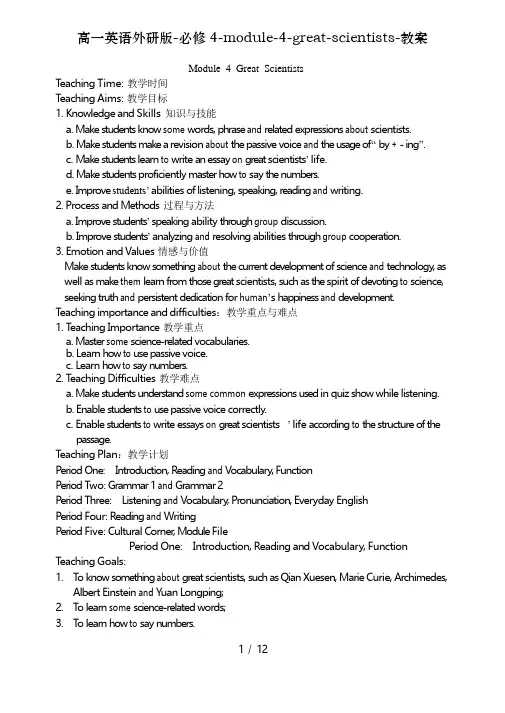
Module4Great ScientistsT eaching Time:教学时间T eaching Aims:教学目标1.Knowledge and Skills知识与技能a.Make students know some words,phrase and related expressions about scientists.b.Make students mak e a revision about the passive voice and the usage of“by+-ing”.c.Mak e students learn to write an essay on great scientists’life.d.Make students proficiently master how to say the numbers.e.Improve students’abilities of listening,speaking,reading and writing.2.Process and Methods过程与方法a.Improve students’speaking ability thr ough group discussion.b.Improve students’analyzing and resolving abilities thr ough group cooperation.3.Emotion and Values情感与价值Make students know something about the current development of science and technology,as well as mak e them learn from those gr eat scientists,such as the spirit of devoting to science, seeking truth and persistent dedication for human’s happiness and development.T eaching importance and difficulties:教学重点与难点1.T eaching Importance教学重点a.Master some science-related vocabularies.b.Learn how to use passive voice.c.Learn how to say numbers.2.T eaching Difficulties教学难点a.Make students understand some common expressions used in quiz show while listening.b.Enable students to use passive voice correctly.c.Enable students to write essays on great scientists’life according to the structure of thepassage.T eaching Plan:教学计划P eriod One:Introduction,Reading and V ocabulary,FunctionP eriod Two:Grammar1and Grammar2P eriod Three:Listening and V ocabulary,Pronunciation,Everyday EnglishP eriod Four:Reading and WritingP eriod Five:Cultural Corner,Module FilePeriod One:Introduction,Reading and Vocabulary,FunctionT eaching Goals:1.T o know something about great scientists,such as Qian Xuesen,Marie Curie,Archimedes,Albert Einstein and Y uan Longping;2.T o learn some science-related words;3.T o learn how to say numbers.T eaching Procedures:Step1:Lead in-----IntroductionBrainstorm:Question:What great scientists do you know?(free speaking)Make students say something about those four great scientists---Qian Xuesen,Marie Curie, Archimedes,Albert Einstein.Name Nationality Major Invention/Discovery Time of thediscovery Qian Xuesen China Physics,Chinese atom bomb In1964MathematicsMarie Curie Archimedes P olandSicily in ItalyPhysicsPhysics,RadioactivitybuoyancyIn1898About240BC mathematicsAlbert Einstein Germany/Mathematical relativity In1905 America PhysicsMake students learn some words of different fields in science.Subjects Biochemistry Biology Botany Chemistry Genetics Physics Zoology Chinese meaning生化学生物学植物学化学遗传学物理学动物学The person who research the subjectsBiochemistBiologistBotanistChemistGeneticistPhysicistZoologistMake students finish exercise2on page31individually.The answers:1.zoology2.botany3.biology4.physics5.biochemistry6.chemistry7.genetics Step2:Reading and Vocabulary1.From the title“The Student Who Asked Questions”,guess what the passage is about?Who is the student?Question:What do you know about Y uan Longping?Name Nationality Major Invention/Discovery Time of thediscoveryY uan Longping China Agriculture Hybrid rice In19702.Make students find the topic sentence of each paragraph.Para1:Y uan Longping is a leading figure in the rice-growing world.Para2:As a boy,he was called“the student who asked questions”.Para3:As a y oung teacher,he began experiments in crop breeding.Para4:He discovered a special type of rice plant.P ara5:His discoveries increased Chinese rice production.P ara6:The yield of the new hybrid rice is much greater than that of other types gr own in Pakistan.3.Make students skim the passage and find the answers to the following questions.1)What kind of studen t was Y uan Longping when he was young?2)What way did he think to pr oduce rice more quickly?3)What did he discover?4)How important was the discovery?The possible answers:1)He was a stude nt with lots of questions and he was interested in plants.2)By crossing different species of rice plant,the n he could pr oduce a new plant which could give a higher yield th an either of the original plants.3)He discovered a naturally sterile male rice plant.4)Chinese rice production rose by47.5%in the1990’s.There were other advantages.●50,000square kilometers of rice fields were converted to growing vegetables and othercash crops.●Y uan’s rice was exported to other countries.●His rice’s yield is much greater than the yield of o ther types of rice gr own in Pakistan. 4.Make students read the passage carefully and decide whether the statement are true or false.1).China pr oduces more rice than any other country.2).Y uan Longping ask ed a lot of questions at school.3).He developed a new kind of fast-growing rice.4).The governmen t helped him in his research.5).The new rice replaced vegetables in50thousand square kilometers.6).The new rice is now gr own n other countries,such as Pakistan.The answers:TTTTFT5.Make students finish exercises in activity3and4on page33individually,then checkthe answers.Step3:Language points1.He thought that(the key to feeding people was to have more rice and to pr oduce itmore quickly.)宾语从句the key to sth./doing sth.---的关键to属于“介词”e.g.这就是考试失败的关键。
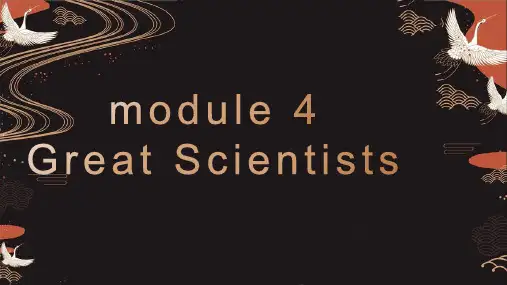
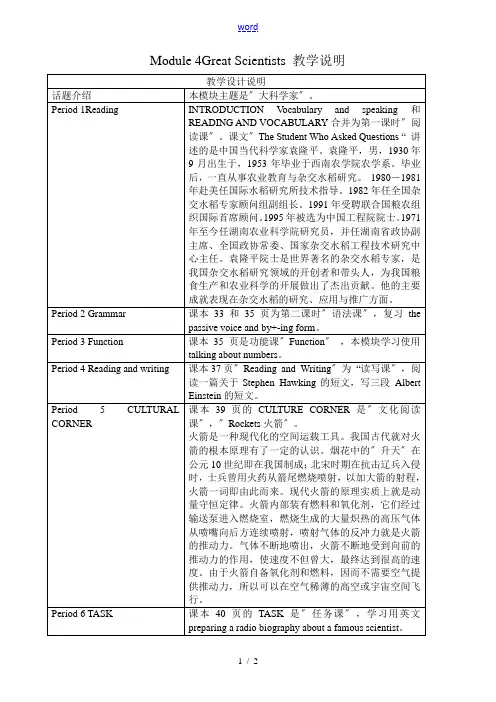
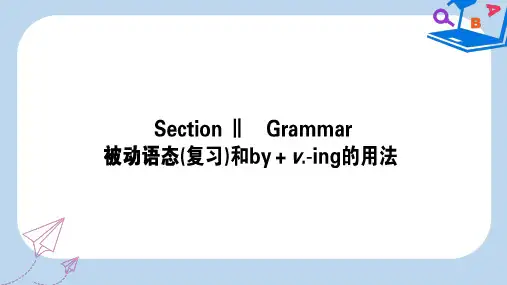
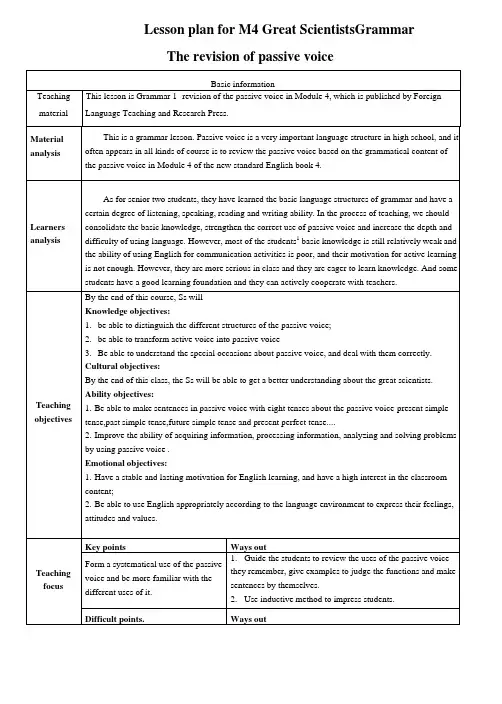
Module 4 Great Scientists 单元概述重要词汇
词汇相关提示
1.support vt.支持掌握support的用法及固定搭配in support of。
2.export vt.输出;出口熟记反义词import与派生词exportation 的用法。
3.quantity n.数量能够区分quantity与quality以及
quantity的用法。
4.replace vt.代替能够区别 take the place of和take place 的区别。
5.career n. 事业;
生涯
掌握career,job和work的区别。
6.explode vt. 爆炸注意explode的意思以及近义词(组)
burst; erupt; blow up。
重点交际句式
个人简介
He/She was born in.... 他/她出生于……
He/She did not...until he was... 直到他/她……岁的时候,他/她才开始做……
When he/she was...,he/she... 当他/她……岁的是时候,他/她……
He/She died in... 他/她死于……
重点语法
掌握各种时态的被动语态以及它们的用法;
掌握并会应用by +doing 的用法。
写作要求
能运用本模块所学的词汇和短语完成所有书面的练习;了解介绍人物生平类文章的主要特点,能够模仿本文的句子结构介绍自己熟悉的人或者是科学家。
文档根源为 :从网络采集整理.word 版本可编写 .支持.必修四模块4语法教案课题教课目的教课要点教课难点Great Scientists课时 1 课时1.Revise some language points.2. Learn more about Grammar of the module .3.Learn to use this Grammar.Revision of passive voiceDeal with some important exercises about it.讲堂导学被动语态复习Revision of passive voice(一 )语态分类英语动词有两种语态,主动语态和被动语态。
主动语态表示主语是动作的履行者,被动语态表示主语是动作的蒙受者。
如:They will build a new bridge over the river. (主动 )A new bridge will be built over the river. ( 被动 )汉语中常用“被” 、“给”、“由”、“受”等词用来表示被动,而英语用:be+过去分词组成。
(二 )被动语态的时态、人称和数的变化主要表此刻 be 的变化上,其形式与系动词be 的变化形式完整同样,列表以下:一般此刻时am/is/are + done一般过去时was/were + done一般未来时Shall + will +be+ done此刻进行时am/is/are+ being+done过去进行时was/were+being +done过去未来时Should/would+b e+done此刻达成时Has/have+been+done过去达成时Had +been + done[注]被动语态没有未来进行时和过去未来进行时。
(三 )被动语态常用的八种时态1.一般此刻时People grow rice in the south of the states._______________________________________________________( 改为被动 )T he school doesn't allow us to enter the chemistry lab without a teacher.We __________________enter the chemistry lab wi thout a teacher. (被动 )2.一般过去时He had a strange way of making his classes lively and interesting.And the students didn't forget his lessons easily.He had a strange way of making his classes lively and his lessons______________________.文档根源为 :从网络采集整理.word 版本可编写 .支持.They will send cars abroad by sea.Cars ___________abroad by sea.They will give plenty of jobs to school-leavers.Plenty of jobs _________________school-leavers.4.过去未来时The manager said they would complete the project by the end of the year.The manager said the project ______________________________________________5.此刻进行时The radio is broadcasting English lessons.English lessons ________________________________________________________6.过去进行时This time last year we were planting trees here.Trees ____________________________________________________7.此刻达成时Someone has told me the sports meet might be put off.I __________________ the sports meet might be put off.8.过去达成时People had considered him to be a great leader.He _______________________________________________9.含有神态动词的被动语态含有神态动词的被动语态是由“神态动词+ be+ 及物动词的过去分词”组成。
二、知识讲解知识点1:复习被动语态(1)各种时态的被动语态的构成例句:English is taught in most schools in China.中国大多数学校都教英语。
(一般现在时)They were given a warm sendoff.他们受到热烈的欢送。
(一般过去时)I’m afraid I am being followed.恐怕我被人跟踪了。
(现在进行时)The case has recently been tried.案子最近已经审过了。
(现在完成时)Their wedding will be held in the church.他们的婚礼将在教堂里举行。
(一般将来时)All the tickets had been sold out when they arrived.他们到达时,所有的票已经售完了。
(过去完成时)(2)使用被动语态时值得注意的几个问题①表示某处有某人或某物的there be结构、主系表结构及不及物动词充当句子的谓语动词时,不能变被动语态。
例句:We study hard.我们努力学习。
②动词have不论表示“有”,还是表示其他动作,虽是及物动词,用于主动语态时可以带宾语,但不可变为被动语态。
例句:We have three meals a day.我们一天吃三餐。
③有些及物动词表示某种情况或状态,而不表示动作,如become,comprise,contain,equal,fit,hold,join,lack,mean,resemble,suit等。
与此相似的look like,consist of,become of,belong to等不可变为被动语态。
例句:I think it’ll fit me quite well before long.我想它很快就会适合我。
④短语动词的被动语态:有些短语动词在意义上相当于及物动词,所以也有被动语态。
短语动词在主动结构中是一个不可分割的词组,在被动结构中也是如此,不可去掉后面的介词或副词。
Module 4 Great Scientists 语法学案(外研版必修4)MODULE4 Grammar语法:被动语态课前导入:翻译下面的句子1.水稻在很多亚洲国家被种植。
________________________________________________________________2.袁隆平在中国出生并被抚养长大。
________________________________________________________________3.小时候,他在很多学校受过教育,并得了一个“爱问问题的学生”的绰号。
________________________________________________________________4.1966年,他的研究成果在中国发表。
________________________________________________________________思考:观察这些句子的共同点?本模块语法学习:被动语态学习目标:1。
被动语态在各种时态下的基本构成2.学习被动语态需要注意的问题课堂探究:一、英语动词有两种语态:主动语态(the Active V oice)被动语态(the Passive V oice)A. 主动语态表示主语是动作的执行者。
We planted the treeB. 被动语态表示主语是动作的承受者。
The tree was planted by us.分析下面的句子:①We speak English. 属于_______语态②English is spoken by us 属于_______语态二、1)构成:被动语态由“助动词be+及物动词的过去分词”构成,助动词be有人称、数的变化,其变化规则与be作为连系动词时一样。
1.规则动词的过去分词:1)一般情况在动词原形后加-ed2)以不发音e结尾的加-d3)以辅音加y结尾的,去y变i加-ed4)以重读闭音节结尾,末尾只有一个辅音字母,先双写该辅音字母,再加-edwatch--_________ practice--___________ study---_________ stop---__________2.不规则动词的过去分词:am\ is\are--_________ have \has---________do--- ________ write----_________ go---________2)各种时态下被动语态的结构:被动语态由“助动词be+及物动词的过去分词”构成,助动词be有人称、数的变化,其变化规则与be作为连系动词时一样。
必修四模块4语法学案课题Great Scientists 课时 1 课时教学目标1.Revise some language points.2. Learn more about Grammar of the module .3.Learn to use this Grammar.教学重点Revision of passive voice教学难点Deal with some important exercises about it.课堂导学被动语态复习Revision of passive voice(一)语态分类英语动词有两种语态,主动语态和被动语态。
主动语态表示主语是动作的执行者,被动语态表示主语是动作的承受者。
如:They will build a new bridge over the river. (主动)A new bridge will be built over the river. (被动)汉语中常用“被”、“给”、“由”、“受”等词用来表示被动,而英语用:be+过去分词构成。
(二)被动语态的时态、人称和数的变化主要体现在be的变化上,其形式与系动词be的变化形式完全一样,列表如下:一般现在时am/is/are + done一般过去时was/were + done一般将来时Shal l+will +be+ done现在进行时am/is/are+ being+done过去进行时was/were+being +done过去将来时Should/would+b e+done现在完成时Has/have+been+done过去完成时Had +been + done[注]被动语态没有将来进行时和过去将来进行时。
(三)被动语态常用的八种时态1. 一般现在时People grow rice in the south of the states._______________________________________________________(改为被动)T he school doesn't allow us to enter the chemistry lab without a teacher.We __________________enter the chemistry lab wi thout a teacher. (被动)2. 一般过去时He had a strange way of making his classes lively and interesting.And the students didn't forget his lessons easily.He had a strange way of making his classes lively and his lessons______________________.3. 一般将来时They will send cars abroad by sea.Cars ___________abroad by sea.They will give plenty of jobs to school-leavers.Plenty of jobs _________________school-leavers.4. 过去将来时The manager said they would complete the project by the end of the year.The manager said the project ______________________________________________5. 现在进行时The radio is broadcasting English lessons.English lessons ________________________________________________________6. 过去进行时This time last year we were planting trees here.Trees ____________________________________________________7. 现在完成时Someone has told me the sports meet might be put off.I __________________ the sports meet might be put off.8. 过去完成时People had considered him to be a great leader.He _______________________________________________9. 含有情态动词的被动语态含有情态动词的被动语态是由“情态动词+ be+ 及物动词的过去分词”构成。
e.g. The teacher said, “You must hand in your compositions after class. ”The teacher said, “Your compositions must be handed in after class. ”He can write a great many letters with the computer.A great many letters ___________________________________________(四)被动语态的使用1. 当不知道或没有必要指出动作的执行者时,常用被动语态,这时往往不用by短语。
“Mr. White, the cup with mixture was broken after class. ”(只是告诉老师杯子坏了,不知是谁弄坏的,或不想说出谁弄坏的)。
2. 突出或强调动作的承受者,如果需要说出动作的执行者,用by短语。
These records were made by John Denver.The cup was broken by Paul.3. 当汉语句子的主语既不是动作的执行者,也不是动作的承受者时,这时常用in+ 名词作状语,而代替by短语。
These cars were made in China.15, 000 cars will be produced each year in the new factory.英译汉:______________________________________________________________(五)主动语态变被动语态的方法1. 把主动语态的宾语变成被动语态的主语。
2. 把主动语态的谓语变成被动语态的be+ 过去分词,时态要与原句保持一致。
3. 把主动语态的主语变为介词by的宾语,放在被动语态里谓语动词之后,by短语可以省略。
如果原句主语是地点名词,在被动语态中用in+ 地点名词作状语。
如:My aunt invited me to her dinner party.主语谓语宾语I was invited (by my aunt )to her dinner party.主语谓语宾语The school set up a special class to help poor readers.A special class to help poor readers was set up in the school.(六)语态转换时所注意的问题1. 把主动语态变为被动语态时,其谓语动词的时态要与原句时态保持一致,其谓语动词的数要与新主语保持一致。
We have bought a new computer.A new computer has been bought. (正确)A new computer have been bought. (错误)2. 含有双宾语的主动句变被动句时,可分别将其中的一个宾语变为主语,另一个不动,一般变间接宾语为主语时比较多。
My uncle gave me a present on my birthday.I was given a present on my birthday.如果把直接宾语(指物)改为主语,则在间接宾语(指人)前加适当的介词,如上句还可以说:A present _______________________________________注意:一般在下列动词后,常在间接宾语前用介词to,如:bring, give, hand, lend, offer, pass, pay, promise, sell, show, take, teach, tell等。
The magazine was passed on to me. _____________________________________The cup with mixture ________________(show)the class. _____________________________一般在下列动词后,间接宾语前用介词for, 如:build, buy, cook, cut, choose, do, fetch, find, fix, get, keep, make, order, paint, play, sing等。
Mother mad e me a new skirt. __________________________________有些既不用to也不用for, 根据动词与介词的搭配关系。
People all over the world know the Great Wall.The Great Wall is known to people all over the world. (不用by短语)3. 由动词+ 介词或副词构成的短语动词,要把它们作为整体看,即把它们看成一个及物动词,介词或副词不可拆开或漏掉。
这类动词有:不及物动词+ 介词,如: agree to, ask for, laugh at, operated on, listen to, look after, think of, talk about 等。
The patient is being operated on. _______________________________________The problem is solved. It needn't be talked about. ____________________________________及物动词+ 副词:如:bring about, carry out, find out, give up, hand in, make out, pass on, point out, put away, put off, think over, turn down, work out, turn out等。